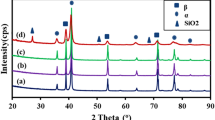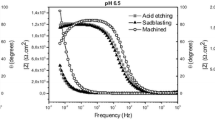Abstract
Surface analytical methods such as scanning electron microscopy (SEM), scanning force microscopy (SFM), energy dispersive X-ray analysis (EDX), and X-ray photoelectron spectroscopy (XPS) were used to study the surface properties of amalgam substitutes as tooth filling materials. In particular the corrosion resistance of new gallium restorative materials was determined. To give relevant practical data, the measurements were performed before and after storing the alloys in artificial saliva to simulate physiological oral conditions. Subsequently an analysis of the artificial saliva was carried out with atomic emission spectroscopy with inductively coupled plasma (ICP-AES). Selective corrosion of different phases and a high gallium release could be determined.
Similar content being viewed by others
Author information
Authors and Affiliations
Additional information
Received: 15 July 1997 / Revised: 20 February 1998 / Accepted: 23 February 1998
Rights and permissions
About this article
Cite this article
Ziegler, C., Reusch, B. & Geis-Gerstorfer, J. Interface analysis of new tooth filling materials. Fresenius J Anal Chem 361, 547–553 (1998). https://doi.org/10.1007/s002160050944
Issue Date:
DOI: https://doi.org/10.1007/s002160050944




